At long last and after several failed efforts, Sears Holdings is filing for Chapter 11 bankruptcy protection and embattled CEO Eddie Lampert, who tried unsuccessfully to prop up Sears with his own money, will step down but remain as chairman.
The company plans to keep its Sears.com and Kmart.com lines open and shutter more stores as it works on restructuring. About 700 stores remain, some with shelves unstocked as vendors have lost trust and patience. The company has closed about 600 stores since early 2017.
Several reports indicated last week that Sears, a retail giant founded in 1892 in Chicago, was looking to making the filing by today, when a debt payment of $134 million came due.
The company said it plans to move through the restructuring process, is committed to its reorganization plan and is continuing negotiations with creditors.
“Sears was gone years ago,” said Brett Rose, CEO of United National Consumer Suppliers, which buys overstock and closeout goods and resells them to retail and ecommerce companies. “Retailers must evolve and grow. For too many years, Sears rested on its laurels. Brand loyalty does not mean what it used to. Today, it’s about convenience and options, neither of which Sears offered. Most consumers and suppliers counted them out some time ago. When you go from 3,500 stores to 500, it doesn’t go unnoticed.”
Rose pointed out how Sears shut down its catalog in 1993, months before the birth of Amazon. “They should not have discarded the millions of catalog shoppers and closed the division,” he said. “It was a golden opportunity to evolve and be at the forefront of online shopping. They dropped the ball.”
Sears has received commitments for $300 million in debtor-in-possession financing from lenders and is negotiating with DIP provider ESL Investments, on top of another $300 million in loans. ESL is the Greenwich, CT-based hedge fund owned by Lampert, who took over as majority shareholder of Sears Holdings in 2005 when it combined with Kmart. He is widely cited for mismanaging the merged company into the ground.
Lampert owns about 31% of Sears Holdings’ outstanding shares, while ESL owns another 19%, according to CNBC.
Sears has filed a number of motions seeking authorization to support its operations during the restructuring process. It said it will continue to pay employees, honor its loyalty member program and pay vendors and suppliers. The fate of those 68,000 workers remains uncertain, pending the outcome of the bankruptcy.
“Over the last several years, we have worked hard to transform our business and unlock the value of our assets,” said Lampert. “While we have made progress, the plan has yet to deliver the results we desired and addressing the company’s immediate liquidity needs has impacted our efforts to become profitable and more competitive retailer.”
Lampert said the Chapter 11 process will give Sears flexibility to strengthen its balance sheet, continue its right-sizing process and hopefully return to profitability.
“Our goal is to achieve a comprehensive restructuring as efficiently as possible, working closely with our creditors and other debtholders, and be better positioned to execute on our strategy and key priorities,” said Lampert.
Sears plans to reorganize around a smaller store platform and is in discussions with ESL regarding a bid for the purchase of a large portion of the company’s stores.
In the meantime, Sears will close an additional 142 unprofitable stores by the end of the year, with liquidation starting soon. This is on top of plans to close 46 stores by November.
Although this filing has been a long time coming, it still feels like “a tremendously poignant day for U.S. retailing,” Alan Treadgold, a global retail lead at PA Consulting.
“It’s difficult to be optimistic that Chapter 11 bankruptcy protection will be enough to save the business,” Treadgold said. “It’s not just a question of whether Sears can restructure fast enough and radically enough. The bigger question is, even if it could achieve all that, is there still a relevant and viable business here?”
The closure of Toys R Us earlier this year evoked similar emotion among retail industry watchers, although Geoffrey the Toys R Us giraffe may have a better shot at a second life than Sears.
MCM Musings: This is a sad ending for an institution that failed to keep up with the times. The company famous for its Sears Roebuck catalog and iconic skyscraper in downtown Chicago did not pivot fast enough to keep up with the rapid pace of the retail revolution, including ecommerce and the growth of omnichannel as a business focus. Many younger shoppers, according to one report, have never set foot in a Sears store. Consumers in general voted with their pocketbooks, ditching Sears’ offerings en masse with the exception of popular hardline brands like Kenmore appliances, DieHard batteries and Craftsman tools; the latter was sold last year to competitor Stanley Black & Decker for $900 million. Ironically, Lampert is reportedly considering a bid for Kenmore as part of the restructuring process, according to Reuters.

